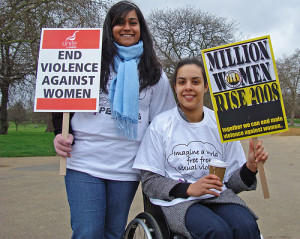 Listed below is a selection of my writings on feminism and women’s liberation, dating from the 1970s to the present. If you are interested in something I’ve written that doesn’t appear here, please let me know and I will try to help. Links to groups, activists and researchers in related areas can be found in Links and Resources.
Listed below is a selection of my writings on feminism and women’s liberation, dating from the 1970s to the present. If you are interested in something I’ve written that doesn’t appear here, please let me know and I will try to help. Links to groups, activists and researchers in related areas can be found in Links and Resources.
The Women’s Liberation Movement has made it possible for many of us for the first time to share and begin to analyse experiences and feelings usually kept private. The slogan that freedom means the possibility of making our desires into reality has been challenged, because we have begun to question the nature of those desires. (1975 Questioning our Desires)
In this letter from 1980, writer and activist Ethel Mannin (1900-1984) refers to her own involvement with anarchism, and comments on anarchists Emma Goldman, Marie Louise Berneri and Kitty Lamb. I had written asking if she would agree to be interviewed by members of the anarchist feminist history group, as part of our research into ... 2024. When British poet and aphorist Elizabeth Gibson Cheyne described herself in ‘Who’s Who’ as a suffragist, socialist and freethinker, she was actively constructing a public identity not just as a writer, but as an activist. But identities can’t be so neatly categorised and controlled. Paper given at the Womens’ History Network annual conference.
2023. British poet Elizabeth Gibson Cheyne contributed to the ferment of new ideas about art, religion, poetry and politics in the early twentieth century. She was a suffragist, socialist and freethinker as well as a poet, and her social networks included artists, feminists, reformers and revolutionaries.
2023. Biographical article about Elizabeth Gibson Cheyne published in the Oxford Dictionary of National Biography online in July 2023.
2014. This short piece draws on Helen Lowe’s own words to give a background to her involvement with the feminist organisation Women Against Fundamentalism. Chapter in Women Against Fundamentalism: stories of dissent and solidarity, eds. Sukhwant Dhaliwal and Nira Yuval-Davis.
2014 (1977). Women activists speak about anarchism, feminism and the interrelationship of the personal and the political in interviews from 1977 by Lynn Alderson and Judy Greenway.
2014. Committed to ‘Art for Life’s Sake’, both poets wrote about suffering, injustice and social responsibility. Similarities and differences in their beliefs show in the form and content of their work. Article from Dymock Poets & Friends, No. 13.
2012. ‘Gautama of India, Jesus of Nazareth, Emerson of Concord, Abdu’l-Bahá of Persia … one God, though called by innumerable beautiful names’, wrote Elizabeth Gibson Cheyne after meeting Abdu’l-Bahá. Talk given at the Commemorative Day celebrating the centenary of Abdu’l-Bahá’s visit to Oxford.
2011. How are ideas of sexual and political dangerousness connected? How can we challenge the polarization between academics and activists, theory and practice, and find new ways of propagating ideas?
Preface to Anarchism and Sexuality: Ethics, Relationships and Power, eds. Jamie Heckert and Richard Cleminson.
2010. Gendered approaches to anarchist history can generate new ideas about anarchism past, present and future.
Paper given at PSA conference, Edinburgh, 2010.
2009. Anarchists and others debate free love in theory and practice. What is the relationship between sexual freedom and social transformation?
Chapter from Laurence Davis and Ruth Kinna, eds, Anarchism and Utopianism.
2008. Researching an unknown relative, poet and feminist Elizabeth Gibson, raised tricky questions of methodology as well as the challenges of combining family history and academic research. Article from Qualitative Research, 2008:8.
2004. Discusses the close relationship between the sibling poets, and the influences on their artistic and political development. Article from Dymock Poets and Friends, No.3.
2003. How did ideas about free love and sexual liberation change among anarchists and libertarians between the 1880s and the 1970s? Paper given at Past and Present of Radical Sexual Politics, Amsterdam.
2002. How do the realistic and practical, the utopian and impossible, become polarised? And what difference does gender make? Discusses women’s fictional and non-fictional accounts of utopian experiments in 1890s England. Article from Geografisker Annaler 84 B.
2002. Joan Crawford meets utopian theory in the outlaw territory of the Temporary Autonomous Zone, in this discussion of the film ‘Johnny Guitar’. Article from Altitude, Vol.2, Article1.
1998. ‘How can one classify and label the different kinds of love?’ Discusses how fin-de-siècle feminists and sexual radicals creatively reinterpreted Weininger’s misogynist theories to challenge restrictive categories of sex and gender. Chapter from Sexology in Culture: Labelling Bodies and Desires, eds. Lucy Bland and Laura Doan.
1997. Do new technologies and new theories of sex, gender, and the body pose a real challenge to existing power relationships? Chapter from Twenty-first Century Anarchism: Unorthodox Ideas for a New Millennium, eds. Jon Purkis and James Bowen.
1993. Problems and tensions between men and women in utopian communities are nothing new, especially when it comes to sharing the housework. Chapter from Diggers and Dreamers 94/95, eds. Chris Coates, Jonathan How, Lee Jones, William Morris, and Andy Wood.
1977. Challenges divisions between the Gay and Women’s Liberation movements, and the indifference of the left, in the context of a violent anti-gay backlash. Article co-authored with Margot Farnham, from Zero 3, October/November 1977.
NEW UPLOAD! 1976. Difficulties in dealing with disagreements and controversy can lead to suppression of dissent and a ‘tyranny of virtue’ within some parts of the Women’s Liberation Movement. This article written in the Seventies has resonances for current debates. From Catcall 4, September/October 1976, pp. 2-6. London: Catcall Collective.
1975. ‘The Women’s Liberation Movement has made it possible to share and begin to analyse experiences and feelings usually kept private.’ Article from Wildcat No.6, March 1975.